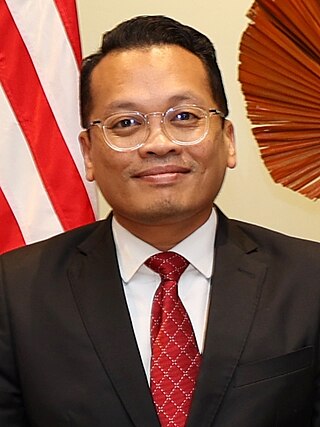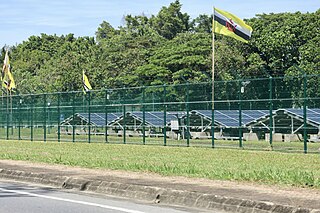
A Zero-Energy Building (ZEB), also known as a Net Zero-Energy (NZE) building, is a building with net zero energy consumption, meaning the total amount of energy used by the building on an annual basis is equal to the amount of renewable energy created on the site or in other definitions by renewable energy sources offsite, using technology such as heat pumps, high efficiency windows and insulation, and solar panels.

Clean technology, in short cleantech or climatetech, is any process, product, or service that reduces negative environmental impacts through significant energy efficiency improvements, the sustainable use of resources, or environmental protection activities. Clean technology includes a broad range of technology related to recycling, renewable energy, information technology, green transportation, electric motors, green chemistry, lighting, grey water, and more. Environmental finance is a method by which new clean technology projects can obtain financing through the generation of carbon credits. A project that is developed with concern for climate change mitigation is also known as a carbon project.

The production of renewable energy in Scotland is a topic that came to the fore in technical, economic, and political terms during the opening years of the 21st century. The natural resource base for renewable energy is high by European, and even global standards, with the most important potential sources being wind, wave, and tide. Renewables generate almost all of Scotland's electricity, mostly from the country's wind power.

Renewable energy commercialization involves the deployment of three generations of renewable energy technologies dating back more than 100 years. First-generation technologies, which are already mature and economically competitive, include biomass, hydroelectricity, geothermal power and heat. Second-generation technologies are market-ready and are being deployed at the present time; they include solar heating, photovoltaics, wind power, solar thermal power stations, and modern forms of bioenergy. Third-generation technologies require continued R&D efforts in order to make large contributions on a global scale and include advanced biomass gasification, hot-dry-rock geothermal power, and ocean energy. As of 2012, renewable energy accounts for about half of new nameplate electrical capacity installed and costs are continuing to fall.

According to data from the US Energy Information Administration, renewable energy accounted for about 13.1% of total primary energy consumption and about 21.5% of total utility-scale electricity generation in the United States in 2022.

A green-collar worker is a worker who is employed in an environmental sector of the economy. Environmental green-collar workers satisfy the demand for green development. Generally, they implement environmentally conscious design, policy, and technology to improve conservation and sustainability. Formal environmental regulations as well as informal social expectations are pushing many firms to seek professionals with expertise with environmental, energy efficiency, and clean renewable energy issues. They often seek to make their output more sustainable, and thus more favorable to public opinion, governmental regulation, and the Earth's ecology.

Renewable energy in the United Kingdom contributes to production for electricity, heat, and transport.

China is the world's leader in electricity production from renewable energy sources, with over triple the generation of the second-ranking country, the United States. China's renewable energy sector is growing faster than its fossil fuels and nuclear power capacity, and is expected to contribute 43 per cent of global renewable capacity growth. China's total renewable energy capacity exceeded 1,000 GW in 2021, accounting for 43.5 per cent of the country's total power generation capacity, 10.2 percentage points higher than in 2015. The country aims to have 80 per cent of its total energy mix come from non-fossil fuel sources by 2060, and achieve a combined 1,200 GW of solar and wind capacity by 2030. In 2023, it was reported that China was on track to reach 1,371 gigawatts of wind and solar by 2025, five years ahead of target due to new renewables installations breaking records.

Nik Nazmi bin Nik Ahmad is a Malaysian politician who has served as the Minister of Natural Resources, Environment and Climate Change in the Unity Government administration under Prime Minister Anwar Ibrahim since December 2022 and the Member of Parliament (MP) for Setiawangsa since May 2018. He previously served as Member of the Selangor State Executive Council (EXCO) in the PR and PH state administrations under former Menteri Besar Azmin Ali from September 2014 to May 2018, Deputy Speaker of the Selangor State Legislative Assembly from June 2013 to September 2014, Member of the Selangor State Legislative Assembly (MLA) for Seri Setia from March 2008 to May 2018, Chairman of the Defence and Home Affairs Select Committee from December 2019 to March 2020 and Political Secretary to the Menteri Besar of Selangor from March 2008 to June 2010. He is a member of the People's Justice Party (PKR), a component party of the Pakatan Harapan (PH) coalition. He has also served as the Vice President of PKR since July 2022. He served as the 3rd Youth Chief of PKR from August 2014 to November 2018, Communications Director of PKR from August 2010 to September 2013, 1st Youth Chief of PH from October 2017 to December 2018 and State Youth Chief of PKR of Selangor.
New Energy for America was a plan led by Barack Obama and Joe Biden beginning in 2008 to invest in renewable energy sources, reduce reliance on foreign oil, address global warming issues, and create jobs for Americans. The main objective of the New Energy for America plan was to implement clean energy sources in the United States to switch from nonrenewable resources to renewable resources. The plan led by the Obama Administration aimed to implement short-term solutions to provide immediate relief from pain at the pump, and mid- to- long-term solutions to provide a New Energy for America plan. The goals of the clean energy plan hoped to: invest in renewable technologies that will boost domestic manufacturing and increase homegrown energy, invest in training for workers of clean technologies, strengthen the middle class, and help the economy.

Google PowerMeter was a software project of Google's philanthropic arm, Google.org, to help consumers track their home electricity usage. It was launched on October 5, 2009 and ended on September 16, 2011. The development of the software was part of an effort by Google to invest in renewable energy, electricity grid upgrades, and other measures that would reduce greenhouse gas emissions. The software was designed to record the user's electricity usage in near real-time. Google partnered with various companies during the project.

The Energy and Resources Institute (TERI) is a research institute in New Delhi that specializes in the fields of energy, environment and sustainable development. Established in 1974, it was formerly known as the Tata Energy Research Institute. As the scope of its activities widened, it was renamed The Energy and Resources Institute in 2003.

100Green, formerly Green Energy UK, is an independent sustainable energy company which sells 100% Ofgem-certified green and renewable electricity and gas, to homes, businesses and organisations in England, Wales and Scotland. 100Green is the only energy supplier in the UK to offer 100% green gas. Based in Ware, Hertfordshire, 100Green was established in 2001 by chief executive officer Douglas Stewart.
Electricity in Cyprus is managed by the Electricity Authority of Cyprus. Power is primarily generated at three fuel oil-burning stations but the use of distributed renewable energy is expanding.

"Sustainability," was defined as “development which implies meeting the needs of the present without compromising the ability of future generations to meet their own needs”as defined by the 1983 Brundtland Commission. As sustainability gains support and momentum worldwide, universities across the United States have expanded initiatives towards more sustainable campuses, commitments, academic offerings, and student engagement.

Only 0.05% of Brunei's power was generated using renewable energy, with the remaining 99.95% coming from fossil fuels. The nation established a 10% renewable energy target in the electricity generating mix by 2035 in 2014. When it comes to renewable energy, Brunei has yet to significantly advance and establish itself as a desirable location for investment. From 2020 to 2035, the percentage of renewables must rise by 0.66% year in order to reach the aim. To further the growth of renewable energy, particularly solar energy, which is more plentiful than wind energy, the nation still has to implement a regulatory framework.
The Green Schools Campaign (GSC) is a Los Angeles based non-profit organization designed to help schools transition to renewable energy. It was founded in 2020 by Simon Aron, Calum Worthy, and Michael Zelniker and has operated using an online-only model throughout its existence. It is currently led by Executive Director Lily Morse, Operations Directors Ghazal Mirzazadeh and Ava Acevedo, Engagement and Intake Director Angeline Aloysius, and Communications Director Natalia Armenta. The Climate Reality Project is the parent organization of the Green Schools Campaign.
Denmark is a leading country in renewable energy production and usage. Renewable energy sources collectively produced 75% of Denmark's electricity generation in 2022, and are expected to provide 100% of national electric power production from 2030. Including energy use in the heating/cooling and transport sectors, Denmark is expected to reach 100% renewable energy in 2050, up from the 34% recorded in 2021.
There is enormous potential for renewable energy in Kazakhstan, particularly from wind and small hydropower plants. The Republic of Kazakhstan has the potential to generate 10 times as much power as it currently needs from wind energy alone. But renewable energy accounts for just 0.6 percent of all power installations. Of that, 95 percent comes from small hydropower projects. The main barriers to investment in renewable energy are relatively high financing costs and an absence of uniform feed-in tariffs for electricity from renewable sources. The amount and duration of renewable energy feed-in tariffs are separately evaluated for each project, based on feasibility studies and project-specific generation costs. Power from wind, solar, biomass and water up to 35 MW, plus geothermal sources, are eligible for the tariff and transmission companies are required to purchase the energy of renewable energy producers. An amendment that introduces and clarifies technology-specific tariffs is now being prepared. It is expected to be adopted by Parliament by the end of 2014. In addition, the World Bank's Ease of Doing Business indicator shows the country to be relatively investor-friendly, ranking it in 10th position for investor protection.

Renewable energy in Palestine is a small but significant component of the national energy mix, accounting for 1.4% of energy produced in 2012. Palestine has some of the highest rate of solar water heating in the region, and there are a number of solar power projects. A number of issues confront renewable energy development; a lack of national infrastructure and the limited regulatory framework of the Oslo Accords are both barriers to investment.
















